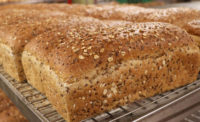Two areas of frozen bakery products that have seen strong traction over the past year are frozen breakfast items like waffles and frozen pizza, with trends like clean label, premium offerings and health-conscious considerations factoring into growth.
Data-driven results
The frozen breakfast food category overall grew 5.09 percent for the 52 weeks ending December 30, 2018 to $3.5 billion, but the frozen waffles segment slightly outperformed the category, up 6.05 percent to $954.6 million. While the Kellogg Co. brand Eggo had a very strong year for its Thick & Fluffy line, up 29.28 percent to $75.6 million, the big story in frozen waffles this past year is Baker Mills, which saw its Kodiak Cakes waffles grow into a nearly $20 million business, with $15.4 million in sales for its Power Waffles and $4.4 million of sales for its Energy Waffles.
Frozen pizza also had an up year, growing 5.0 percent to $4.9 billion. Private label saw the best growth, up 8.21 percent to $639.2 million.
The Albertsons store brand O Organics became a $1 billion brand as of January 2018, and the line is available at many of the grocery banners Albertsons operates across the U.S. Albertsons reported in January 2019 that sales of its own brands had increased to an all-time high during the third quarter of fiscal 2018. The retailer’s more-everyday store brand Signature Select is notably offering upscale options, including an Artisan Pesto & Fresh Mozzarella pizza with a crust made with sprouted whole wheat and ancient grains like sorghum, millet, amaranth, quinoa and teff.
Growth leaders in branded frozen pizza included:
- Schwan’s Co. brand Red Baron, up 7.79 percent to $628.4 million
- Schwan’s Co. brand Tony’s, up 15.55 percent to $106.8 million
- Palermo Villa brand Screamin’ Sicilian, up 10.22 percent to $82.3 million
- Newman’s Own, up 17.62 percent to $72.3 million
- Nestlé brand Lean Cuisine Craveables, up 11.71 percent to $63.3 million
Also, newcomer Caulipower made a strong impression during 2018, with $35.1 million in sales.
Oprah Winfrey’s O, That’s Good! line of frozen pizzas, which debuted in 2018, aren’t gluten-free, but likewise add cauliflower to the crust formula for reduced carbohydrate impact and a vegetable boost.
While cauliflower has seen most of the spotlight over the past year in terms of gluten-free frozen pizza crusts, other vegetables are surfacing in crust substrates. Spinato’s, an Arizona-based pizza chain, offers a nationally distributed gluten-free frozen retail line that includes options with a broccoli-based crust (see “Exclusive interview: Spinato’s, on frozen pizzas and broccoli crust” on www.snackandbakery.com for more on this line).
“For pizza, we’re seeing trends of both indulgent craft-style pizza and health-conscious pizza,” says Laurie Fallucca, chief creative officer, Palermo Villa, Inc., Milwaukee, WI. “We have responded by offering brands that adapt to these trends, while also filling our consumers’ desire for innovation in toppings and crust platforms.”
Health and wellness often manifests itself as clean label in frozen bakery items like pizza. “Our Urban Pie pizza features a thin artisan crust, 100 percent real rBST-free cheese and meats raised without antibiotics,” says Fallucca. “And, of course, no artificial colors, flavors or preservatives.”
Millennial family households are driving growth in the frozen category, suggests Giselle Restrepo, senior manager, strategic insights and trends, Schwan’s Co., Minneapolis. “Millennial parents are four times more likely to eat frozen snacks vs. non-parent millennials.” They’re seeking “fresh and real” ingredients, pointing to Mintel research that notes nearly 70 percent of millennial parents rate high-quality, fresh foods as important.
Restrepo also suggests that products developed for youth demographics should meet high quality standards. “Parents have higher standards for what their kids snack on than for themselves, but their key drivers for choosing frozen snacks are taste and convenience, a reflection on where they are in their busy lives.”
Strategies for continued growth
Two of the most-important trends driving sales of frozen breakfast items like waffles are unique sizes, such as mini products, and health considerations, says Michael Niemczyk, sales and business development manager, TSA Griddle Systems, Carrollton, TX. He notes heathy ingredients are seeing increased attention, including a continuing move toward gluten-free, whole-grain, more fiber and no preservatives.
Brook Carson, vice president product development and marketing, Manildra Group USA, Leawood, KS, sees the combination of simple labels and multifunctional ingredients as responsible for increased attention in the freezer aisle—ideally meeting both needs with one ingredient solution. “For example, instead of adding one ingredient to improve sheeting during process and another to improve quality after frozen storage, use a single ingredient to provide both benefits.”
The desire for clean label has resulted in the need to replace many core ingredients historically used in frozen bakery products, notes Carson. “Many bakery and frozen food additives are no longer acceptable to a wide range of consumers.” She notes that Manildra GemPro wheat proteins can develop the gluten network need for process and product texture, but that its flexible network also pulls double-duty to maintain optimum quality throughout shelf life.
“The freezer aisle is enjoying a resurgence as frozen snack makers respond to changing consumer demands,” says Pam Stauffer, global marketing programs manager, Cargill, Minneapolis. “Increasingly, they’re serving up products made with more-healthful—and recognizable—ingredient choices, a fact that busy consumers are rewarding with increased sales.” She also notes that Cargill has received Non-GMO Project Verification for a number of products, including stevia, erythritol, chicory root fiber, starches and maltodextrins.
Cargill’s SimPure portfolio of label-friendly, functional native starches can help manufacturers replace modified starches while maintaining great texture, notes Shiva Elayedath, senior technical services manager, Cargill. “In particular, our SimPure 99560, a blend of potato and tapioca starches, and SimPure 99500, a potato starch, both have applications in frozen snacks and appetizers.” These starches help with freeze/thaw stability, texture and viscosity, working in both acidic and neutral pH systems.
Health will likely factor into continued growth. Janice Johnson, Ph.D., technical and applications services lead, Cargill Salt, points to Innova Market Insights data showing bakery has experienced the largest growth of “low sodium” product launches, with over 14,000 new products released between 2016 and 2019 in the U.S. But frozen foods category often feature high sodium due to the important functionalities salt can bring, including microbial management and flavor enhancement. She suggests using Potassium Pro potassium chloride, a common substitute for sodium chloride, to cut sodium and boost potassium. It can reduce sodium up to 50 percent in some food applications.
“Consumer desire for clean, natural and healthy foods continues to drive frozen snack and bakery offerings,” says Michael Buttshaw, vice president of ingredients sales and marketing, MGP Ingredients, Atchison, KS. “Beginning with non-GMO and identity-preserved ingredients, we also see products that use natural emulsifiers to extend freshness. ‘Empty’ carbohydrates will be replaced with fiber and proteins.” He also predicts increased demand for vegetable-based toppings on pizzas, along with “thin, crispy and light” pizza crusts.
From a flavor perspective, Buttshaw predicts more smoky and sweet flavors in 2019. “Smoked and roasted cheeses, for example, will provide an extra pop of flavor on everything from pizza to hand-held snacks. Smoky, sweet peppers will be popular.”








